NOCITA for Cats
This page contains information on NOCITA for Cats for veterinary use.The information provided typically includes the following:
- NOCITA for Cats Indications
- Warnings and cautions for NOCITA for Cats
- Direction and dosage information for NOCITA for Cats
NOCITA for Cats
This treatment applies to the following species: Company: Elanco US
Company: Elanco US
(bupivacaine liposome injectable suspension)
13.3 mg/mL
For use as a peripheral nerve block in cats only
Local Anesthetic
Single use vial
NOCITA for Cats Caution
Federal (USA) law restricts this drug to use by or on the order of a licensed veterinarian.
Description
NOCITA (bupivacaine liposome injectable suspension) is a sterile, non-pyrogenic white to off-white, preservative-free, aqueous suspension of multivesicular lipid-based particles containing bupivacaine. Each milliliter of NOCITA contains 13.3 mg/mL of bupivacaine. Inactive ingredients and their nominal concentrations are: cholesterol, 4.7 mg/mL; 1,2-dipalmitoyl-sn-glycero-3 phospho-rac-(1-glycerol) (DPPG), 0.9 mg/mL; tricaprylin, 2.0 mg/mL; and 1,2 dierucocylphosphatidylcholine (DEPC), 8.2 mg/mL. Bupivacaine is related chemically and pharmacologically to the amide-type local anesthetics. Chemically, bupivacaine is 1-butyl-N-(2, 6-dimethylphenyl)-2-piperidinecarboxamide with a molecular weight of 288.4.
Bupivacaine structural formula is shown in the illustration.
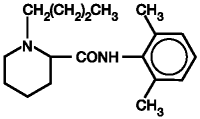
Indication:
For use as a peripheral nerve block to provide regional postoperative analgesia following onychectomy in cats.
Dosage and Administration
NOCITA is for administration only once prior to surgery. Administer 5.3 mg/kg per forelimb (0.4 mL/kg per forelimb, for a total dose of 10.6 mg/kg/cat) as a 4-point nerve block (described below) prior to onychectomy. Administration prior to surgery may provide up to 72 hours of pain control.
Prepare Dose(s):
● Wear gloves when handling and administering NOCITA (see WARNINGS).
● NOCITA should not be allowed to come into contact with topical antiseptics. When a topical antiseptic such as povidone iodine or chlorhexidine is applied, the area should be allowed to dry before NOCITA is administered.
● Do not shake vial. Invert the vial multiple times to re-suspend the particles immediately prior to withdrawal of the product from the vial.
● Do not puncture the vial multiple times. Puncture the vial stopper once with a single 25 gauge or larger needle. Use aseptic technique to sequentially attach and fill sterile syringes. Each syringe should be prepared for single patient use only. Discard the vial after all doses are withdrawn.
● Following withdrawal from the vial into a syringe, NOCITA may be stored at controlled room temperature of 68° F to 77° F (20° C to 25° C) for up to 4 hours. Because the formulation does not contain preservative, the syringe(s) must be discarded after 4 hours.
● Do not dilute NOCITA prior to use as a nerve block in cats.
Do not mix with water or other hypotonic solutions as it will result in disruption of the liposomal particles (see CLINICAL PHARMACOLOGY).
Do not mix NOCITA with other local anesthetics or other drugs prior to administration (see PRECAUTIONS).
● Use a 25 gauge or larger bore needle for administration.
Dose Administration:
● Aspirate prior to injecting to prevent intravascular administration (see CONTRAINDICATIONS).
Table C-1. Dose Administration for One Forelimb.1

Dose Volume per Injection (% of total 0.4 mL/kg/forelimb volume) and Description
A. 0.14 mL/kg (35%)
Superficial Branch of the Radial Nerve: At the center of the limb, on the dorsal aspect at the level of the antebrachiocarpal joint, insert the needle subcutaneously with the bevel up (•). Advance the needle subcutaneously as depicted by the dotted line and arrow and inject (o) adjacent to the confluence of the accessory cephalic and cephalic veins.
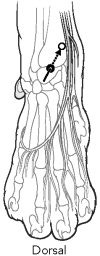
B. 0.08 mL/kg (20%)
Dorsal Branch of the Ulnar Nerve: Palpate a groove between the accessory carpal bone (ACb, in the base of the carpal pad) and the styloid process of the ulna (SpU). Distal to this groove, insert the needle subcutaneously with the bevel up and advance the needle proximally. Inject once the tip reaches the midpoint of the groove.
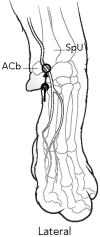
C. 0.16 mL/kg (40%)
Median Nerve and Superficial Branch of the Palmar Branch of the Ulnar Nerve: Insert the needle subcutaneously with the bevel up lateral to the distal tip of the accessory carpal pad and advance the needle medially 2/3 the width of the limb, until the tip is located near the base of the first digit. Inject 2/3 of the volume at this point and the remaining volume while withdrawing the needle (solid grey arrow). Gently massage for 5 seconds.
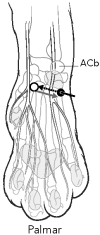
D. 0.02 mL/kg (5%)
Deep Branch of the Palmar Branch of the Ulnar Nerve: Orient the needle perpendicular to the long axis of the limb at the level of the ACb. Insert the needle subcutaneously and advance the needle laterally until it contacts the medial aspect of the ACb. Redirect the needle dorsally by rotating the needle 90° advance it along the medial side of the ACb 2-3 mm until it penetrates the flexor retinaculum, and inject.
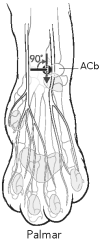
Contraindications
Do not administer by intravenous or intra-arterial injection. If accidental intravascular administration occurs, monitor for cardiovascular (dysrhythmias, hypotension, hypertension) and neurologic (tremors, ataxia, seizures) adverse reactions.
Do not use for intra-articular injection. In humans, local anesthetics administered into a joint may cause chondrolysis.
Warnings
Not for use in humans. Keep out of reach of children.
NOCITA is an amide local anesthetic. In case of accidental injection or accidental topical exposure, contact a physician and seek medical attention immediately.
Wear gloves when handling vials to prevent accidental topical exposure.
Precautions
Do not administer concurrently with bupivacaine HCl, lidocaine or other amide local anesthetics. A safe interval from time of bupivacaine HCl, lidocaine or other amide local anesthetic administration to time of NOCITA administration has not been determined. The toxic effects of these drugs are additive and their administration should be used with caution including monitoring for neurologic and cardiovascular effects related to toxicity.
The safe use of NOCITA in cats with cardiac disease has not been evaluated.
The safe use of NOCITA in cats with hepatic or renal impairment has not been evaluated. NOCITA is metabolized by the liver and excreted by the kidneys.
The ability of NOCITA to achieve effective anesthesia has not been evaluated.
The safe use of NOCITA in cats for surgical procedures other than onychectomy has not been evaluated.
The safe use of NOCITA has not been evaluated in cats younger than 5 months old.
The safe use of NOCITA has not been evaluated in cats that are pregnant, lactating, or intended for breeding.
Adverse Reactions
Safety was evaluated in 120 NOCITA treated cats and 121 saline (placebo) treated cats in a field study in cats undergoing onychectomy. Cats enrolled in the study were 5 months to 10 years of age, and weighed 2.0 to 9.3 kg. NOCITA was administered as a 4-point peripheral nerve block at a dose of 5.3 mg/kg per forelimb (0.4 mL/kg per forelimb).
Table C-2: Adverse Reactions Reported During the Study in the Safety Population (any cat that received treatment)
|
Adverse Reaction |
NOCITA (n = 120) |
Saline (n = 121) |
|
Elevated body temperature* |
8 (6.7%) |
5 (4.1%) |
|
Surgical site infection |
4 (3.3%) |
1 (0.8%) |
|
Chewing/licking of surgical site |
3 (2.5%) |
2 (1.7%) |
|
Diarrhea |
2 (1.7%) |
1 (0.8%) |
|
Injection site erythema |
1 (0.8%) |
0 (0.0%) |
|
Swelling of paw; erythematous digits |
1 (0.8%) |
0 (0.0%) |
Note: If an animal experienced the same event more than once, only the first occurrence was tabulated.
* Elevated body temperature was defined as temperature 103° F on Day 3 and normal before surgery. One of the NOCITA treated cats had an infection of one surgical site. No other cat with elevated body temperature showed evidence of infection or illness.
Eight cats, 4 in each group, had normal platelet counts before treatment on Day 0 and platelet counts below the reference range (155,000-641,000/µL) on Day 3. The 4 cats treated with NOCITA had platelet counts of 42,000 to 100,000/µL, and the 4 cats in the saline group had platelet counts of 114,000 to 149,000/µL. Decreased platelet counts were not associated with clinical signs.
In a pilot study with 62 cats undergoing onychectomy (31 cats treated with NOCITA and 31 with saline), one NOCITA treated cat had a motor deficit (unilateral knuckling) which resolved by the next morning following surgery. Another NOCITA treated cat had bruising at the injection sites.
To report suspected adverse events, for technical assistance or to obtain a copy of the Safety Data Sheet (SDS), contact Elanco US Inc. at 1-888-545-5973.
For additional information about adverse drug experience reporting for animal drugs, contact FDA at 1-888-FDA-VETS or http://www.fda.gov/reportanimalae
Clinical Pharmacology
Bupivacaine is an amide, non-opioid local anesthetic. It provides local analgesia by deactivating sodium channels on the nerve membrane, preventing the generation and propagation of nerve impulses. It is only present in small concentrations as uncharged molecules at tissue pH as it is a base with pKa of 8. This un-ionized form provides a lipophilicity that permits the drug to traverse across the nerve cell membrane and upon entering the cell, binds to the intracellular portion of voltage-gated sodium channels and blocks sodium influx into nerve cells, which prevents depolarization. Without depolarization, no initiation or conduction of a pain signal can occur.
Lipid Formulation
Liposomal encapsulation or incorporation in a lipid complex can substantially affect a drug’s functional properties relative to those of the unencapsulated or nonlipid-associated drug. In addition, different liposomal or lipid-complexed products with a common active ingredient may vary from one another in the chemical composition and physical form of the lipid component. Such differences may affect functional properties of these drug products. Do not substitute with other bupivacaine formulations.
After injection of NOCITA, bupivacaine is released from the multivesicular liposomes over a period of time.
Pharmacokinetics
The pharmacokinetic characterization associated with bupivacaine after subcutaneous NOCITA (bupivacaine liposome injectable suspension) or bupivacaine HCl solution administered to cats evaluated for 168 hours is provided in Table C-3.
Table C-3. Plasma pharmacokinetic parameters for bupivacaine after single subcutaneous administration of NOCITA and bupivacaine HCl solution in male and female cats in a laboratory study.
|
PK Parameter |
NOCITAa 3 mg/kg |
NOCITAa 9 mg/kg |
NOCITAa 15 mg/kg |
bupivacaine HCl 1 mg/kg |
|
N |
6 |
6 |
6 |
6 |
|
Tmaxb (hr) |
12.5 (1-48) |
10 (1-24) |
1.5 (1-24) |
1 (1-4) |
|
Tlastb (hr) |
108 (72-144) |
120 (72-168) |
144 (120-168) |
18 (12-24) |
|
Cmaxc (ng/mL) |
311.4 (82.2-565) |
620.2 (374-892) |
709.7 (462-1090) |
263.9 (60.5-506) |
|
AUC(last)c (ng*hr/mL) |
11347 (5176-15767) |
32561 (19390-47532) |
38475 (26460-48252) |
1608 (314-2363) |
a 5.3 mg/kg NOCITA bupivacaine base is equal to 6 mg/kg bupivacaine HCl. NOCITA doses in this table are in the bupivacaine HCl equivalent.
b Median (range)
c Mean (range)
Tmax = time to maximum plasma concentration
Tlast = time to last quantifiable plasma concentration
Cmax = maximum plasma concentration
AUClast = area under the curve from the time of dosing to the last quantifiable plasma concentration
Following a single subcutaneous dose of NOCITA, there was a less than dose proportional increase in Cmax and AUClast across the dose range tested (3-15 mg/kg). There was a high variability in all reported parameters. Half-life is not reported for NOCITA in cats because the prolonged absorption confounds the estimation of the terminal elimination phase. Therefore, Tlast is included as a more appropriate measure of the duration of quantifiable plasma concentrations.
Effectiveness
Effectiveness was demonstrated in a multi-center, placebo-controlled, randomized and masked field study in client-owned cats undergoing bilateral forelimb onychectomy. In this study, 241 cats were enrolled in the study and randomized to treatment with NOCITA (n = 120) or saline (placebo, n = 121).
Cats received an opioid analgesic just prior to general anesthesia and surgery. The nerve block injection sites were shaved and a standard surgical preparation with chlorhexidine or povidone iodine was used. Prior to onychectomy, NOCITA or saline was administered as a 4-point nerve block (see DOSING INSTRUCTIONS).
Pain was assessed by trained observers using a modified version of the UNESP-Botucatu Multidimensional Composite Pain Scale for up to 72 hours following extubation. Pain assessments were conducted prior to surgery, and at 0.5, 1, 2, 4, 8, 12, 24, 30, 36, 48, 56 and 72 hours post-surgery. Cats with a composite pain score ≥ 6 or that were determined to be painful by the assessor received rescue analgesic medication and were classified as treatment failures. After receiving rescue analgesia, cats did not have further pain assessments performed. The primary variable for effectiveness was evaluated over the first 24-hour time interval. The percent of treatment success for NOCITA was significantly greater than saline for the 0-24 hour time interval (p = 0.0252). The 0-48 hour and 0-72 hour time intervals were evaluated as secondary variables and support effective use of NOCITA for up to 72 hours of analgesia.
Table C-4. Number and Percent Effectiveness for NOCITA and Saline (Placebo) Groups at each Time Interval
|
Time Interval for Pain Evaluation |
NOCITA |
Saline |
|
0-24 hours |
88/117 (75.2%) |
48/119 (40.3%) |
|
0-48 hours |
79/115 (68.7%) |
41/118 (34.7%) |
|
0-72 hours |
78/114 (68.4%) |
42/119 (35.3%) |
The per protocol populations for effectiveness varied for each pain assessment time interval because of protocol deviations affecting only one of the three time intervals for some cats.
Animal Safety:
In a 22 day laboratory study, 40 healthy cats (4 cats/sex/group) aged 5-6 months were administered negative control (2.37 mL/kg saline), active control (5.3 mg/kg bupivacaine HCl), or NOCITA at 10.6, 21.2, or 31.8 mg/kg via injection using a suprainguinal approach for a femoral nerve block of the right hindlimb on Days 0, 9 and 18. These NOCITA doses correspond to 1, 2 and 3 times the maximum labeled total dose of 10.6 mg/kg/cat (representing 2, 4 and 6 times the maximum labeled dose of 5.3 mg/kg/forelimb).
Two cats died during the study. One male in the active control group died during recovery from anesthesia after the second dose and no definitive cause of death was determined. One female in the 31.8 mg/kg group was euthanized on Day 15. This cat developed a suppurative, open, necrotic wound over the region of the right stifle after the second dose administration.
For the cats who survived the study, there were no clinically relevant treatment-related effects on electrocardiograms, hematology, serum chemistry, urinalysis, coagulation, and organ weights. Right hindlimb impairment was expected because the entire dose was administered as a femoral nerve block. Right hindlimb impairment occurred in 23 of the 24 NOCITA cats which persisted for 1-5 days; 2 negative control cats which persisted for 1 day; and none of the active control cats. Left hindlimb impairment was observed the day after the first dose in one cat in the 21.2 mg/kg group. NOCITA treatment-related findings were observed on histopathology of soft tissue and the femoral nerve at the injection sites. Injection site soft tissue histopathology findings included subacute or chronic inflammation, mineralization, myofiber degeneration and myofiber necrosis. Injection site femoral nerve histopathology findings included subacute or chronic inflammation.
Sporadic clinical observations and histopathology findings throughout both negative and active control groups and NOCITA groups included: soft or watery or mucoid stool; inguinal swelling on the right hindlimb noted after only the first dose; abrasions or scabbing noted at the right abdominal and inguinal regions as well as on the right hindlimb and at the right stifle; histopathology findings at or near the injection site or right stifle included ulceration and suppurative crusts on the skin, histopathology findings at the injection site of subcutaneous foreign material and fibrosis, and myofiber regeneration.
Storage Conditions:
Unopened vials should be stored refrigerated between 36° F to 46° F (2° C to 8° C)
NOCITA may be held at a controlled room temperature of 68° F to 77° F (20° C to 25° C) for up to 30 days in sealed, intact (unopened) vials. Do not re-refrigerate. Do Not Freeze.
How Supplied
13.3 mg/mL bupivacaine liposome injectable suspension in 10 mL or 20 mL single use vial.
10 mL supplied in 4-vial carton. 20 mL supplied in a single vial carton and 4-vial carton.
Approved by FDA under NADA # 141-461
Manufactured for:
Elanco US Inc., Greenfield, IN 46140 USA
Nocita, Elanco and the diagonal bar logo are trademarks of Elanco or its affiliates.
Rev. date 03/2021
Reference:
1. Location and relative volumes based on: Enomoto M, Lascelles BDX and Gerard MP. Defining the local nerve blocks for feline distal thoracic limb surgery: a cadaveric study. Journal of Feline Medicine and Surgery. 2016 18 (10): 838-845.
PA103060X
CPN: 1131093.0
2500 INNOVATION WAY, GREENFIELD, IN, 46140
| Customer Service: | 317-276-1262 | |
| Technical Service: | 800-428-4441 | |
| Website: | www.elanco.us | |
| Email: | elanco@elanco.com |
 |
THIS SERVICE AND DATA ARE PROVIDED "AS IS". DVMetrics assumes no liability, and each user assumes full risk, responsibility, and liability, related to its use of the DVMetrics service and data. See the Terms of Use for further details. |
Copyright © 2024 Animalytix LLC. Updated: 2024-02-27
